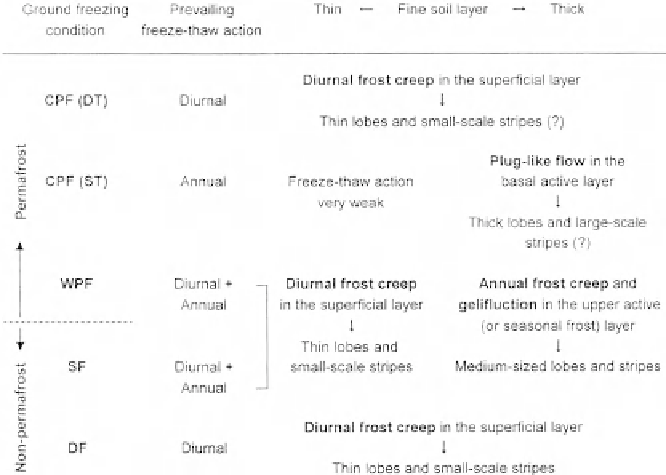Geology Reference
In-Depth Information
Figure 9.9.
Freeze-thaw regimes and solifl uction. Legend for frost types: CPF (DT), cold perma-
frost with diurnal thaw; CPF (ST), cold permafrost with seasonal thaw; WPF, warm permafrost;
SF, seasonal frost; DF, diurnal frost. From Matsuoka (2001c). Reprinted from Earth Science
Reviews, with permission from Elsevier.
to the ground surface is
h
, and soil settles vertically upon thaw, the potential frost creep
(
∆
l
) parallel to the surface is:
∆
lh
=
tan
σ
(9.1)
In the case of two-sided freezing, which is the situation when dealing with permafrost
environments, frost creep may exceed the amount calculated from Equation (9.1). The
growth of ice lenses at the top of permafrost during freeze-back means that the potential
frost creep (
l
) varies from a maximum in the thickest part of the ice lens to zero at the
periphery. Furthermore, towards the end of the thaw period, a residual ice lens in a soupy
matrix may make a larger contribution to total movement than that of
∆
l
due to vertical
settlement. This causes plug-like fl ow, where hummocks slide over water-saturated sedi-
ment lying immediately above the permafrost table.
∆
9.4.3. Gelifl uction
Conditions suitable for gelifl uction occur in areas where downward percolation of water
is limited by frozen ground and where melt of segregated ice lenses provides excess water
which reduces internal friction and cohesion in the soil. Locations of abundant moisture,
such as below late-lying or perennial snow banks, are especially favored.
Gelifl uction is essentially a process operating mainly during the thaw period. It is
laminar in nature; movement decreases with depth in a linear fashion. Usually, movement
is restricted to the uppermost 50 cm of the active layer.

